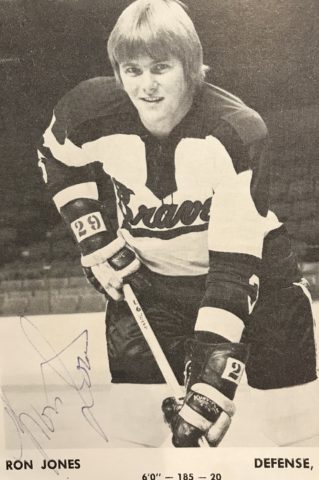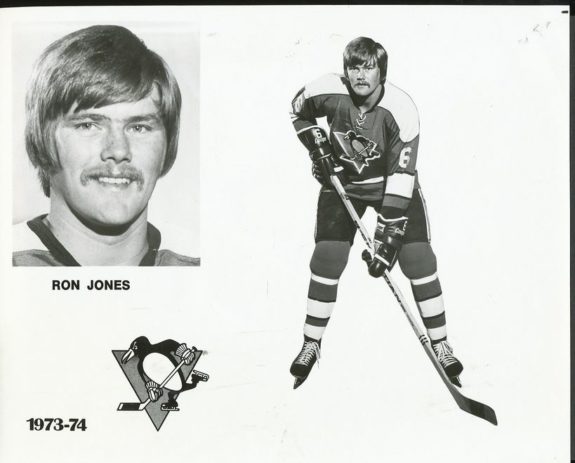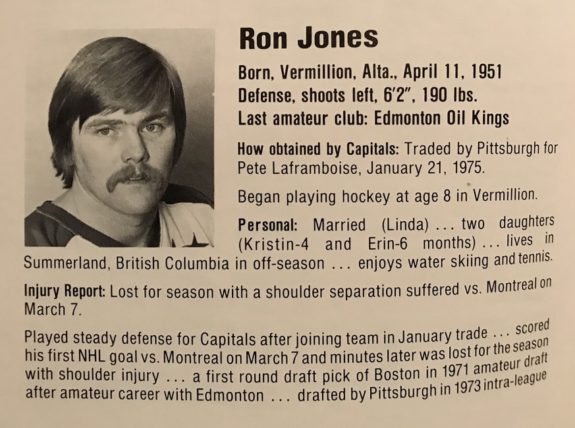Former NHL defenseman Ron Jones had a successful hockey career, even if that success did not transfer to the NHL. The 6-foot-1, 200-pound blueliner was an offensive-defenseman during his junior hockey career with the Edmonton Oil Kings of the Western Canada Hockey League (today’s current WHL). Jones moved the puck well enough and contributed substantially on offense that the Boston Bruins took notice and sought to make him one of their own. Any faltering after he was drafted into the NHL stemmed more from injuries creating lost opportunities, as opposed to a lack of talent or effort.
The “Big, Bad Bruins” of the early-1970s were an offensive juggernaut. Prior to the 1971 NHL Amateur Draft taking place in June, Boston was a record-setting hockey club. The 1970-71 Bruins scored an astounding 399 goals to lead the entire league by more than 100 tallies. The legendary centerman Phil Esposito set the scoring record at the time with 76 goals in 78 games, to go along with 152 points. Arguably the greatest defender to ever play the game, Bobby Orr scored 37 goals that season, 102 assists, and a whopping 139 points in 78 games as well.
From the HHOF Archives – Phil Esposito and Bobby Orr collect some silverware from NHL president Clarence Campbell. pic.twitter.com/cSi8yl3Dk0
— Hockey Hall of Fame (@HockeyHallFame) July 21, 2016
Having such a powerful offense already – not to mention a true physicality in the likes of players such as Wayne Cashman, Johnny McKenzie, Don Awrey and more – adding another offensive talent to the back end seemed very fitting. Boston opted to select Jones as the sixth overall pick in 1971. While he would end up playing 54 NHL regular season games, only eight of those came as a Bruin. Never playing more than 25 games in a season, Ron Jones goes down in history as one of our forgotten first-rounders.
A Successful Junior Career with the Oil Kings
From 1967 to 1971, Jones forged a junior career with the Oil Kings. A native of Vermilion, AB, he was essentially playing junior hockey in his own backyard, despite a two-hour driving distance. Jones’ numbers went up each year with Edmonton, and his offensive skills from the blueline continued to develop.
Case in point, during Jones’ WCHL season of 1967-68 – at just 16 years of age – he played in 48 games for the Oil Kings, and generated a goal and five assists. As age and experience accumulated, so increased Jones’ playing time and performance. Though his sophomore season saw him play two less games, he improved his goal production to a pair and upped his assist total to 11.
Jones’ finest two seasons with the Oil Kings were his last two. For the 1969-70 season he truly hit his stride. In 52 games he tallied seven goals and 33 assists. The best was yet to come for Jones and his teammates.
The 1970-71 Edmonton Oil Kings were loaded with what would eventually become NHL talent. Along with Jones, the team included players like Don Kozak, Dave Kryskow, Darcy Rota, Phil Russell, and Stanley Cup champion Tom Bladon. It was more than enough talent to lead the Oil Kings to the top of that year’s standings with a record 45-20-1 for 91 points. Jones led all Edmonton defenders in scoring with 11 goals and 40 assists for 51 points in 63 games.
Jones and the Oil Kings would make it all the way to the 1971 Memorial Cup championship, where they would lose two games to none in a best-of-three series against the Quebec Remparts. Despite the loss, a strong season from Jones on the whole caused his draft stock to rise. Boston’s sights were set right on him.
A Brief Stay in Beantown

After being drafted by the Bruins, Jones’ career in Beantown was quite brief but it did help get his feet wet. In his first year playing pro – the 1971-72 season – he played just one game for the Bruins, while playing 74 out of 76 games for the team’s AHL affiliate, the Boston Braves. Jones’ lone game with the Bruins that first year was the team’s final regular season game of the 1971-72 season – a 6-4 victory over the visiting Toronto Maple Leafs. He played quite well during the game, putting three shots on goal and finishing as a plus-one. An interesting side note is that this same game was also the first NHL game in the career of Bruins legend Terry O’Reilly. Jones and O’Reilly played the entire season together with the AHL Braves, before being inserted into the Bruins’ lineup for the last game of the year. In his first NHL game, O’Reilly scored his first NHL goal.
Jones would play one more year with the Bruins’ organization. During the 1972-73 season he would see seven games of action with the parent club, but was kept pointless. Getting the chance to play with the Bruins from Oct. 26 through Nov. 16, Jones could not capitalize on the opportunity – at least not in terms of offense. In the seven game stint he did not even get a shot on goal. Subsequently, he was returned to the Braves. In the AHL Jones totaled three goals and 25 assists for 28 points in only 55 games, which still spoke to his ability as an offensive-defenseman.
Shortly after the 1972-73 season came to a close, his time with the Bruins was officially through. Having not been protected, the Pittsburgh Penguins claimed Jones in the Intra-League Draft on Jun. 12, 1973 and made him their own. For a team that had very little potency from their defense, grabbing Jones was considered a bit of a steal for the Penguins.
Jones’ Longest Tenure Was With the Pens
With Pittsburgh is where Jones’ would have his longest NHL tenure. Up to this point in time, the Penguins never truly had a puck-moving defenseman since their inception into the league in 1967. During their first six years in the league, the team only made the playoffs twice. The hope was that the addition of Jones could fill an offensive role on “D”, and change the fortunes of the team. Unfortunately for Jones and the Penguins, that would not materialize.
Their newly acquired blueliner played with the team from the start of the 1973-74 season, through the autumn, and into the first couple weeks of December. In what would amount to 25 regular season games, Jones only recorded three assists and was a minus-14. He did however hit some notable firsts during this time. Jones recorded his first NHL point in his first game with the Penguins on Oct. 12, 1973, picking up the secondary assist on a goal by Al McDonough. He would also have his first NHL fight from tangling with the New York Rangers’ Ted Irvine in the opening period of a 7-2 drubbing of the “Blueshirts” on Oct. 28, 1973. Oddly enough, this was arguably Jones’ finest game as a Penguin, as he would tie for the team lead that night in plus/minus with a remarkable plus-five.

The less than expected overall performance though was not enough to secure him a spot in Pittsburgh. Still, every cloud has a silver lining. As Jones was sent down to the team’s AHL affiliate, the Hershey Bears, to finish out the season, he would be part of a championship winning team. The 1973-74 Bears finished second overall in the league’s Southern Conference with a record of 39-23-14. They also possessed a decently talented roster with NHL caliber players like 35-year-old veteran Duane Rupp, and young players like Dennis Owchar, Hank Nowak, Robin Burns, and goaltender Denis Herron.
Jones would play 34 regular season games for the Bears, and contributed 11 assists. He played in all 14 playoff games as well, as Hershey defeated the Cincinnati Swords in the opening round, the Baltimore Clippers in the semis, and finally the Providence Reds in the championship. Winning the Calder Cup that year would be the only professional championship of Jones’ career, and it became the fifth championship in Hershey history.
Becoming an Original Capital
The 1974-75 NHL season marked the addition of two new expansion teams, the Kansas City Scouts and the Washington Capitals. Both teams fared abysmally during their first year in the league, with the Capitals assembling the worst record in NHL history (8-67-5). Jones would begin the 1974-75 season as a member of the Penguins organization, but playing only with Hershey in the AHL. A freak water skiing accident in the summer of 1974 saw him injure ligaments in his leg. Rather than be a possible detriment to the Penguins, Jones was kept in Hershey for conditioning. That is until the Penguins looked to make a trade with the lowly Capitals.
On Jan. 20, 1975 Pittsburgh shipped Jones to Washington, and received center Pete Laframboise in return. Laframboise was not a bad option to have at forward, as he formerly put up 16 goals and 25 assists for the California Golden Seals during the 1972-73 season. The Penguins felt they could use him as a quality fourth line centerman behind Syl Apps Jr., Ron Schock, and a budding star in Pierre Larouche. Meanwhile, the Capitals added Jones as a blueliner who was fresh off of a championship season, and could possibly make the most of an opportunity to shine on a much maligned roster.
#Pens acquire C Pete Laframboise from #Capitals in exchange for D Ron Jones, Jan. 20 1975. pic.twitter.com/awQVYA9aNB
— Penguins History (@penguinshistory) January 23, 2016
One can’t go as far as saying that Jones disappointed. Rather, he just did not have enough of an opportunity before he was struck by bad luck. Jones would play 19 games with the Capitals after coming over in the trade, and was able to score a goal and an assist. Additionally, he picked up 16 penalty minutes.
On Mar. 7, 1975, just 6:23 into the second period, Jones would beat Canadiens goalie Michel “Bunny” Larocque to score his first and only NHL goal. The Capitals, as was often the case for their entire beleaguered season, were crushed by the Canadiens by a score of 8-4. Nelson Pyatt and Mike Marson picked up the assists on Jones’ goal. Minutes after he scored his first NHL goal, Jones suffered a season-ending shoulder injury in the game, and his year was over.
He would only play two more NHL games after that, both coming with the Caps the following season of 1975-76.
What Might Have Been
Ron Jones’ final professional season came in 1976-77. He would spend the entire year with Hershey (who by this point were the minor league affiliate of the Buffalo Sabres). In 36 regular season games Jones chipped in nine assists. He would play in all six playoff games for the Bears, who would be booted four games to two against the Nova Scotia Voyageurs. Jones would retire from playing professional hockey at the end of the season.

While he may have become forgotten, one cannot consider him a failure. Jones played in a Memorial Cup championship, won a Calder Cup in the AHL, and played in the NHL with three different teams. One would have to figure that had he not encountered both the on-ice and off-ice injuries, he likely could have had a longer standing career, especially with the Capitals. While the entire 1974-75 Washington squad is often considered a disaster, had Jones not gotten injured right after scoring his lone goal it might have changed his fortunes into becoming a mainstay for the club. At the very least, he probably would have spent more of the 1975-76 season in Washington instead of just the two games.
We look back on Jones’ 54 NHL games wishing that the fates would have turned out differently for him. Heck, just imagine if he had been partnered with Bobby Orr for any considerable length of time while the two were in Boston together. Orr could have vaulted any D-partner’s performance, and given the proper time, chemistry could have been generated between he and Jones. Unfortunately, things did not turn out that way. We do have to recognize though that Jones had notable achievements in hockey, regardless of just a few brief NHL glimpses of him.